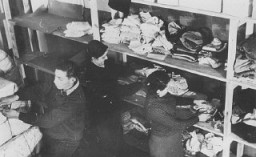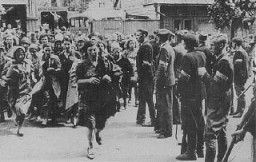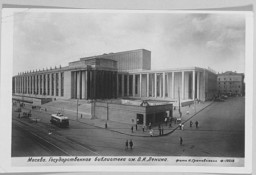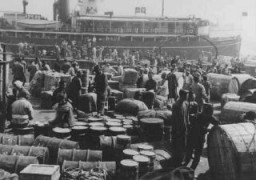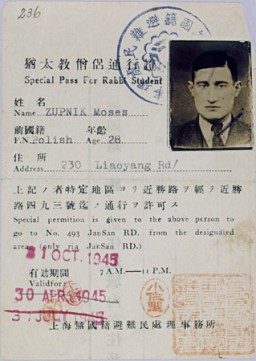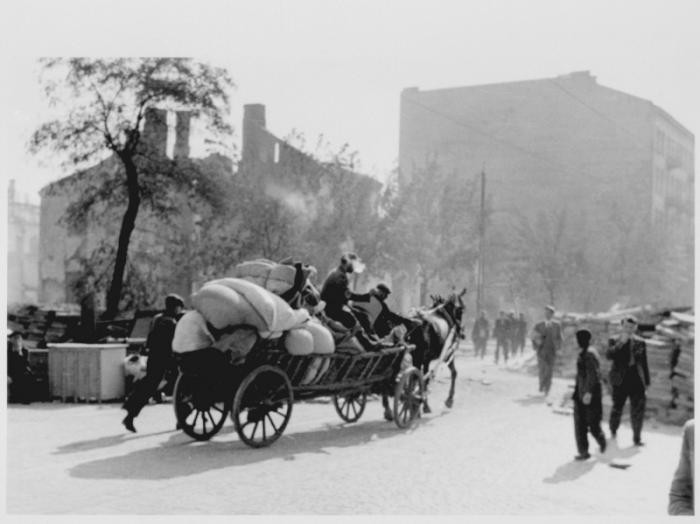
German Invasion of Poland: Jewish Refugees, 1939
When Germany invaded Poland in September 1939, hundreds of thousands of Jewish and non-Jewish refugees fled the advancing German army into eastern Poland, hoping that the Polish army would halt the German advance in the west. Many of the refugees fled without a specific destination in mind. They traveled on foot or by any available transport—cars, bicycles, carts, or trucks—clogging roads to the east. Most took only what they could carry.
Because they had fled so suddenly, few refugees made contingency plans or took the time to prepare adequately for a long journey. After the partition of Poland between Germany and the Soviet Union, the Polish government fled the country and established a government-in-exile in London. Polish refugees in eastern Poland faced the prospect of a long exile from home.
When the Soviets annexed eastern Poland, about 300,000 Jewish refugees from German-occupied Poland were trapped. The vast majority of these refugees remained in Soviet-occupied Poland. In 1940 and 1941, Soviet secret police officials arrested and deported—as "unreliable elements"—hundreds of thousands of residents of eastern Poland, including thousands of Jewish refugees from German-occupied Poland. Those arrested were deported to Siberia, central Asia, and other locations in the interior of the Soviet Union. About 40,000 Jewish refugees continued their flight from Poland, fearing arrest and persecution in either German- or Soviet-occupied territory. More than half of those who fled Poland went to Romania and Hungary. 15,000 went to Lithuania, most to Vilna, Kovno, and the surrounding regions.

Thousands of refugees escaped to the south and booked passage on ships leaving Black Sea ports in Bulgaria and Romania. To reach British-controlled Palestine, their ultimate destination, the boats needed to refuel in Turkey. However, Turkish authorities sought to prevent the refugees from traveling through their country unless the refugees had permits from Britain to enter Palestine. The British White Paper of May 1939 had severely limited Jewish immigration to Palestine.
Turkish policy restricting the transit of refugees to Palestine reduced the possibilities for escape and ultimately led to tragedy. In February 1942, the ship Struma sank off the coast of Turkey. It was carrying 769 Jewish refugees attempting to reach Palestine. Turkish authorities had refused to allow the boat to dock in Istanbul and had towed it out into the Black Sea. Within hours the boat sank, most likely as the result of a torpedo hit from a Soviet submarine whose commander may have mistaken it for an Axis supply ship. Only one "Struma" passenger survived.
The Hungarian government tolerated the entry of Jewish refugees from neighboring Poland and Slovakia and generally did not deport Hungarian Jews to German-occupied territory. After the German occupation of Hungary in March 1944, however, Hungarian authorities deported both Hungarian Jews and Polish Jewish refugees alike. The Germans murdered the majority in Auschwitz-Birkenau in the spring and summer of 1944.
Of the 15,000 Polish Jews who found refuge in Lithuania, one group of 2,100 Polish Jews escaped eastward. Their long flight took them from Lithuania across 6,000 miles by the Trans-Siberian Railroad to Vladivostok and then by steamer to Japan. Few of these refugees could have escaped without the tireless efforts of many individuals. The most critical assistance came from unexpected sources: representatives of the Dutch government-in-exile and of Nazi Germany's ally, Japan. Their humanitarian activity in the summer of 1940 was the pivotal act of rescue for Polish Jewish refugees temporarily residing in Lithuania.
Some refugees could not escape Poland before Soviet and German authorities established their control of the country. By the time some refugees reached the German-Soviet demarcation line as well as Poland's borders with her neighbors they found both closed and heavily guarded. Some refugees attempted to sneak across, often at great danger. Those caught trying to cross between occupation zones or trying to flee without papers faced arrest and arbitrary violence at the hands of both Soviet and German border guards.
For others, the prospect of permanent exile away from home was overwhelming. Penniless, tired of aimless wandering, and despairing of seeing their families in the German-occupied zone of Poland again, some refugees headed home, back across the German-Soviet demarcation line into German-occupied Poland.
Series: Flight and Rescue
Critical Thinking Questions
- What pressures and motivations affected the officials and leaders of other countries as they faced the prospect of German Jews trying to enter their territory?
- What obligations, if any, do other countries have for assisting refugees?


